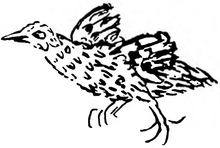Peter Mundy
Peter Mundy (fl. 1597 – 1667) was a seventeenth-century British merchant trader, traveller and writer. He was the first Briton to record, in his Itinerarium Mundi ('Itinerary of the World'), tasting Chaa (tea) in China and travelled extensively in Asia, Russia and Europe.[1]
Life
Mundy came from Penryn in south Cornwall. In 1609 he accompanied his father, a pilchard trader [2] to Rouen across the Channel in Normandy, and was then sent to Gascony to learn French. In May 1611 he went as a cabin-boy in a merchant ship, and gradually rose in life until he became of independent circumstances.

He visited Constantinople, returning to London and overland via Bulgaria, Sarajevo, Split, Venice, Chambéry and Paris with the English Ambassador Paul Pindar, and afterwards made a journey to Spain as a clerk in the employ of Richard Wyche. Following Wyche's death and a brief spell in the family Pilchard business, he returned to London and obtained employment on account of his language skills, travelling experience and reference from Pindar, with the East India Company on a salary of 25 pounds. On 6 March 1628 he left Blackwall for Surat (India), where he arrived on 30 September 1628. In November 1630 he travelled to Agra and remained there until 17 December 1631, when he proceeded to Puttana on the borders of Bengal. He returned to Agra and Surat, and leaving the latter in February 1634, arrived off Dover on 9 September 1634. This portion of his travels is contained in the Harleian MS. 2286, and in the Addit. MSS. 19278-80.
As a fisherman and sailor it is likely that he spoke at least some Cornish of which he makes some account of its relation to Welsh, visiting Wales (and climbing Ysgyryd Fawr) in 1639 where he noted "few of the common or poorer sort understand any English at all".[3]
He went on further voyages to India, China, and Japan, when he started from the Downs on 14 April 1636. His journals record his being served "Chaa" or tea by the Chinese and tasting chocolate aboard a Spanish merchant vessel. The fleet of four ships and two pinnaces were sent out by Sir William Courten, and Mundy seems to have been employed as a factor. His journals end somewhat abruptly, but a manuscript in the Rawlinson collection at the Bodleian Library continues the narrative of his life, spending many years living in the Hansa free city of Dantzig - modern Gdansk - including journeys to Denmark, Prussia, and Russia, which lasted from 1639 to 1648. Mundy himself made the drawings for the volume and traced his routes in red on the maps of Hondius. In 1663 he declared his travelling days over and retired to Falmouth, his journals record his own calculation of the distance he had travelled in his many voyages as 100,833 and 5/8th miles. His manuscripts were lost for nearly 300 years and then published by the Hakluyt Society.
Philip Marsden's history of Falmouth, The Levelling Sea, published in 2011, provides a brief account of Peter Mundy's life on pages 131–137.
He also left the earliest description of the Musaeum Tradescantianum.[4]
Character
"It is rare to find a man so representative of his period as was Peter Mundy. In an age when curiosity was the outstanding characteristic of intelligent Englishmen, curiosity was the ruling passion of this life. ... His insatiable appetite for information, his eye for detail, his desire for accuracy, would have made him in modern times a first-rate scientist. ... True to his period, also, was his heartlessness ... he was more interested in the appearances of things than their implications in the lives of human beings. ... But if he was unfeeling, he was by no means insensitive; each strange item in the surprising world he had inherited is described with a spontaneous brilliance seldom to be found in modern writing."[5]
Notes
- Peter Mundy, Merchant Adventurer, Ed. R E Pritchard, 2011, Bodleian Library, Oxford
- "His father was engaged in 'the pilchard business'." Carrington, Dorothy (1949) The Traveller's Eye. London: Pilot Press; p. 178
- Peter Mundy, Merchant Adventurer, ed. R.E. Pritchard, 2011, Bodleian Library Press, Oxford; p, 148
- http://www.ashmolean.org/ash/amulets/tradescant/tradescant03.html
- Carrington, Dorothy (1949) The Traveller's Eye. London: Pilot Press; p. 178-79
References
